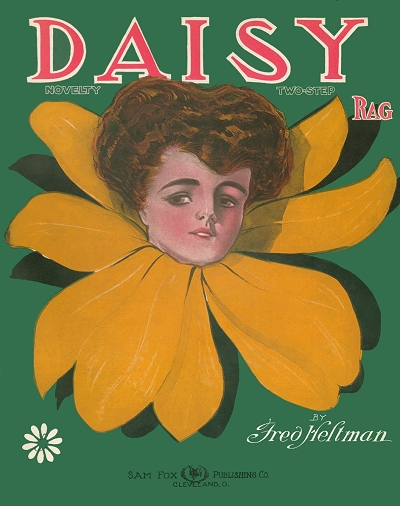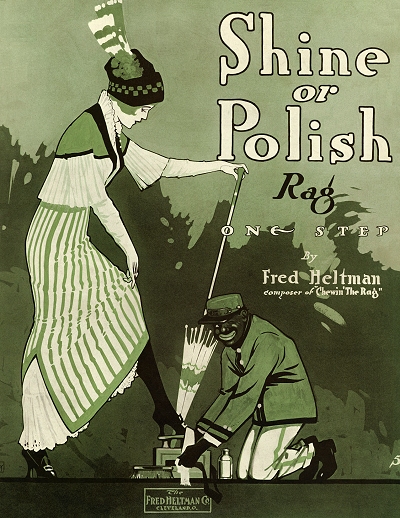Fred Heltman is hard to categorize as either publisher or composer, since he remained active in both fields for many years and with lasting result. Information on him is scarce, but as much as is known is included here. An only child, he was born in Ashland in Northern Ohio to grocer John Hall Heltman and Carrie B. Dresskell.  Fred received at least the normal musical training given to young people of the time, but his early entry into the field of publishing as well as composing suggests some additional professional training beyond just piano lessons. He was listed in the 1900 enumeration as "at school," likely still residing in the family's home in Cleveland.
Fred received at least the normal musical training given to young people of the time, but his early entry into the field of publishing as well as composing suggests some additional professional training beyond just piano lessons. He was listed in the 1900 enumeration as "at school," likely still residing in the family's home in Cleveland.
 Fred received at least the normal musical training given to young people of the time, but his early entry into the field of publishing as well as composing suggests some additional professional training beyond just piano lessons. He was listed in the 1900 enumeration as "at school," likely still residing in the family's home in Cleveland.
Fred received at least the normal musical training given to young people of the time, but his early entry into the field of publishing as well as composing suggests some additional professional training beyond just piano lessons. He was listed in the 1900 enumeration as "at school," likely still residing in the family's home in Cleveland.A few years later, in 1906, publisher Sam Fox opened his first office in Cleveland and started soliciting work, particularly in the growing popular music field. At first much of the output from the Fox firm included the standard fare of marches, waltzes, two-steps, etc. However, Heltman, who had been at college, finally submitted his first rag to the publisher in 1908, and with Daisy Rag he made a credible name both for himself and for Fox. The following year, following Fox's lead, Fred opened his own publishing concern in Cleveland, and led things off with a reprint of Daisy Rag followed by Sunflower Babe. Sometime during that year he became an associate of fellow musician Albert Harvey Eastman, two decades his senior. Eastman had already been in the publishing business in Cleveland, but seemed to welcome Heltman in a way that energized both of them.
With Eastman as a mentor as well as a partner full of experience and good advice, the duo turned out a handful of good songs over the next decade. Eastman was also a violinist, and he helped expand the Heltman repertoire with a number of pieces written and arranged for both bowed and plucked strings, as well as some older classics that appeared in the catalog including some from his own short-lived firm. By 1910, likely a bit earlier, Heltman had moved out of the family home and was staying with his uncle, Cyrena J. Gilbert and his family, as shown in the census. Neither of his parents were readily located in that record, but it was found that his mother survived until 1925. Eastman also showed himself as a music publisher that year, but since his own firm was largely defunct by this time, it can be assumed it was in partnership with Heltman, or at least soon to be so. Heltman married Evelyn A. Learn in Port Stanley, Elgin, Ontario Province, Canada, across Lake Erie from Cleveland, on June 26, 1911. As his wife was Canadian, this was possibly at her parent's residence.
Fred Heltman's reputation quickly spread, and so did his circulation. Whether it was by design or a matter of economics, he used very clean and austere covers with attractive illustrations and his easily identifiable logo at the bottom. In 1912 he turned out one of his biggest hits, Chewin' the Rag, grabbing him more national attention. Equaling this feat, he came up with Shine or Polish Rag two years later. In the interim Heltman sought incorporation in 1913 as the Fred Heltman Company with an initial capital stock of $10,000 in January 1913.  As with Fox, Heltman was actively seeking additions to his catalog, but was perhaps a little more selective in his choices as his output paled by comparison to that of the Fox organization by the mid-1910s. He did, however, have the advantage as a composer and musician as well, of being able to pick what was most consistent for his firm, lending a hand as an arranger from time to time, with Eastman working often in that capacity as well. Some of the items were reprints of older classical works or new arrangements for piano and other instruments, primarily violin as per Eastman's lead. He handled most of the editing of everything from popular Beethoven reprints to old hymns and Christmas tunes. One other musician that joined forces with Heltman for a time was Hungarian immigrant and music teacher Stephan Füzy, who also published as both a lyricist and an instrumental composer. He would later work for the W.P.A. in the 1930s.
As with Fox, Heltman was actively seeking additions to his catalog, but was perhaps a little more selective in his choices as his output paled by comparison to that of the Fox organization by the mid-1910s. He did, however, have the advantage as a composer and musician as well, of being able to pick what was most consistent for his firm, lending a hand as an arranger from time to time, with Eastman working often in that capacity as well. Some of the items were reprints of older classical works or new arrangements for piano and other instruments, primarily violin as per Eastman's lead. He handled most of the editing of everything from popular Beethoven reprints to old hymns and Christmas tunes. One other musician that joined forces with Heltman for a time was Hungarian immigrant and music teacher Stephan Füzy, who also published as both a lyricist and an instrumental composer. He would later work for the W.P.A. in the 1930s.
 As with Fox, Heltman was actively seeking additions to his catalog, but was perhaps a little more selective in his choices as his output paled by comparison to that of the Fox organization by the mid-1910s. He did, however, have the advantage as a composer and musician as well, of being able to pick what was most consistent for his firm, lending a hand as an arranger from time to time, with Eastman working often in that capacity as well. Some of the items were reprints of older classical works or new arrangements for piano and other instruments, primarily violin as per Eastman's lead. He handled most of the editing of everything from popular Beethoven reprints to old hymns and Christmas tunes. One other musician that joined forces with Heltman for a time was Hungarian immigrant and music teacher Stephan Füzy, who also published as both a lyricist and an instrumental composer. He would later work for the W.P.A. in the 1930s.
As with Fox, Heltman was actively seeking additions to his catalog, but was perhaps a little more selective in his choices as his output paled by comparison to that of the Fox organization by the mid-1910s. He did, however, have the advantage as a composer and musician as well, of being able to pick what was most consistent for his firm, lending a hand as an arranger from time to time, with Eastman working often in that capacity as well. Some of the items were reprints of older classical works or new arrangements for piano and other instruments, primarily violin as per Eastman's lead. He handled most of the editing of everything from popular Beethoven reprints to old hymns and Christmas tunes. One other musician that joined forces with Heltman for a time was Hungarian immigrant and music teacher Stephan Füzy, who also published as both a lyricist and an instrumental composer. He would later work for the W.P.A. in the 1930s.Despite the stiff but friendly competition from Fox, now bolstered by the addition of another transplanted Hungarian, John Stephan Zamecnik, Heltman managed to keep his firm viable well into the 1920s. He still declared himself as a music publisher in the 1920 enumeration. At least a couple of reports on the Heltman company, including an interview with Eastman in 1921, indicate that they were shipping as many as an impressive one million sheets per year. Fred was one of the earliest ragtime composers to publish a folio of their own works. His Six Rags by Fred Heltman closely followed the publication of his final rag, appropriately named Fred Heltman's Rag. This piece would be revisited in the early 1950s by pianist Lou Busch (as Joe "Fingers Carr), appearing on a popular single and retitled Riviera Rag. Although a few pieces would follow, Heltman focused more on publishing than composing as the 1920s progressed. In a June 1922 article in The Music Trade Review, which talked about his continuing expansion, Heltman made clear his feelings about current music trends.
Decided turn in popular fancy for music is predicted by Mr. Heltman. It is his belief that the time is not too far distant when jazz, so-called, will be a thing of the past. In short, material with artistic merit is coming into its own again, as is attested by the increase in demand for ballads, and airs with sweetness, melody and simplicity as their reason for being.
If the general public had actually shared this sentiment then his firm might have lasted a bit longer. As it was, they rode part much of the 1920s with rearrangements and reissues of even more standard classical works and method boosk than in the prior decade, plus a handful of new works.
Already blessed with son Frederick W. in 1912 and daughter Harriet in 1914, another daughter was born to the Heltmans in 1923, for whom he named one of his last pieces, Mary Jane Waltz. By the time of the 1930 enumeration, the elderly Eastman was managing a music store, and Heltman, living in Lakewood outside of Cleveland, was suffering from the Great Depression as many other print publishers of that time. He persisted, but the primary output during that difficult decade was reissues and a few originals by other composers. Copyrights for anything except renewals pretty much ceased in 1940. As of the 1940 enumeration in taken Lakewood, Ohio, Fred and Evelyn had their daughter Mary Jane, now 17, still living with them, along with his widowed father John, who had recently moved in with them. He was still listed as the owner of a music publishing house.
It is hard to trace what happened to the firm but by the mid-1940s the catalog had been sold, much of it to the McKinley Music Company in Chicago. Around that time Fred and Evelyn moved to Michigan. The 1950 census showed the Heltmans residing in Hiawatha, Michigan, at the Arrowhead Inn Resort, where they were employed as cottage cleaners. It was in Michigan that Fred died in the summer of 1960. Thousands of his elegantly-covered sheets can yet be found in collections around the world well into the 21st century, and many of his rags are still performed today.
 Compositions
Compositions